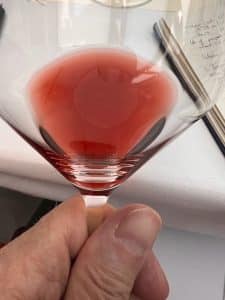There are not many tastings which show that your understanding of a grape variety is completely wrong. But Schiava becomes Vernatsch or new generation Vernatsch was one such event. Organised by Walter Speller, Italy editor of JancisRobinson.com, he persuaded nine producers who make new style Vernatsch to come to London from Alto Adige/Südtirol to show their wines. The first flight was all 2019 wines which in itself was remarkable as Schiava is generally used to make light, early-drinking wines which don’t age well. What is the secret?


Schiava challenges
Schiava’s problems are multiple. It is a generous grape variety that can produce large bunches and big yields but to the detriment of quality. If irrigated, the bunches and grapes get ever larger. In the past, it was mainly grown on pergola which can be seen as old fashioned and certainly labour intensive. Inexpensive red wine for early drinking was released early and mainly drunk either in the region or in Switzerland or Austria. In the last 50 years or so, the fashion in Alto Adige was to replace it with the highly profitable Pinot Grigio, Pinot Bianco, Chardonnay, Cabernet Sauvignon or Merlot. In short, the international brigade that the region does so well. As a result, the number of hectares planted with Schiava has dropped from 3,600 in 1973 to just 467 today. For the sake of comparison, there are a whopping 11,000 hectares of Pinot Grigio in the region today.
New/old Vernatsch
Given all these problems, it is courageous of several mainly younger growers to continue to make the wine and to develop a new/old style. Instead of making a simple red wine to be drunk young, they have focused on high-quality grape growing, longer maceration on the skins (two to four weeks) and then ageing in neutral oak barrels for a minimum of a year but often more. This is in some way a return to the past, at least in terms of winemaking. It has also proved quite controversial in the region as the style is so different to the standard Schiava. These wines are still relatively pale ruby in colour but with the first garnet notes; they have fruit concentration and above all they have a notable tannic structure. OK, we are not talking Sangiovese or Nebbiolo-levels of tannin but they have the structure to age in the bottle. The wines are Schiava or Vernatsch to cellar, a wine for grown ups. In effect, an addition to Italy’s rich heritage of ageable red wines if still lighter in style, more versatile with food, than many of its other wines.

The comparison which inevitably sprung to my mind was with the two styles of Grignolino in Piemonte. Most examples of this wine are fresh, aromatic and intended to be drunk in the next couple of years. By contrast, the Monferace style is also a return to the past: long maceration on the skins and very long ageing in wood for powerful, tannic, savoury wines. There the comparison ends: even long oak-aged Schiava is a gentler wine than the naturally-tannic Grignolino.
If you can read German or Italian, you can read more about the DNA Vernatsch initiative here. In any case, let’s welcome a new-old style wine with Schiava becoming Vernatsch. With the current fashion for lighter, lower alcohol, refreshing red wines, Vernatsch’s second coming may have indeed started.
With thanks to the participating wineries: Ghirlan the co-operative which has kept the flag flying for Schiava; Griesbauhof, Bergmannhof, reyter, Andi Sölva, Pranzegg, Castell Sallegg, In Der Eben and Hartmann Donà.

